Heat is the transfer of thermal energy from one object to another. The transfer of thermal energy can occur by conduction, convection, or radiation. Some materials can store more energy than others.
To better understand Heat: Transfer of Thermal Energy…
LET’S BREAK IT DOWN!
Heat, thermal energy, and temperature
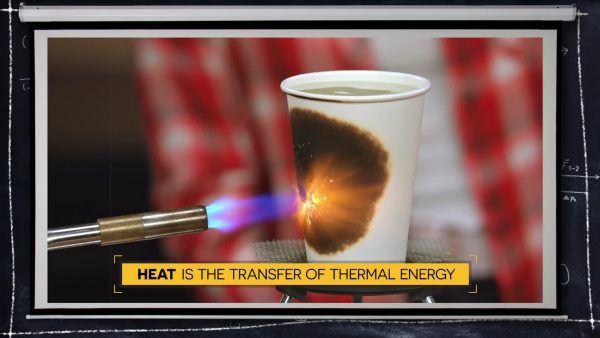
We all have a feel for what temperature is, and we even have a shared language to qualitatively describe temperature. The water in the shower feels warm. It’s cold outside. Don’t touch that, it’s hot! But defining temperature scientifically is not so easy. Basically, temperature is what the thermometer reads. To understand what that means, we have to think about substances at the macroscopic level (we can see it with our eyes) and at the particle level (atoms and molecules that make up the substance, which are too small to be seen with just our eyes).
Hot coffee in a cup may appear to be motionless, but the particles that are contained within it have kinetic energy. At the particle level, the atoms and molecules that make up the coffee are vibrating, rotating, and moving through the space of the cup. Stick a thermometer in the cup of coffee, and you will see evidence that the water possesses kinetic energy. The water’s temperature, as reflected by the thermometer’s reading, is a measure of the average amount of kinetic energy of the coffee molecules.
You know from experience that if you leave the hot cup of coffee sitting on the countertop over time it will cool down. On the macroscopic level, the coffee and the cup are transferring heat to their surroundings (i.e., the air and the countertop). The fact that the coffee’s temperature decreases over time is evidence that the average kinetic energy of its particles is decreasing. We refer to this transfer of energy from the coffee and the cup to the surrounding air and countertop as heat. Heat is the transfer of energy from hotter objects or regions to colder objects or regions.
Transfer by conduction
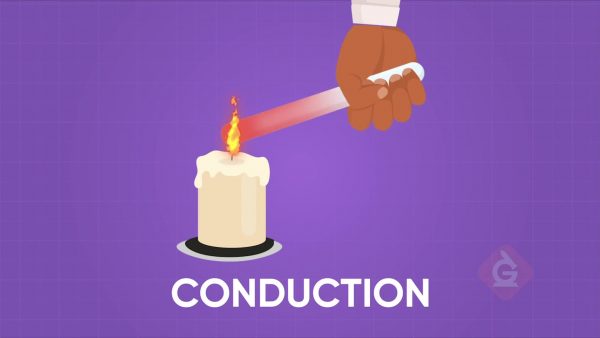
Warming and cooling is the macroscopic result of the particle-level motion. The mechanism in which thermal energy is transferred from one object to another object through particle collisions is known as conduction. During conduction, there is no net transfer of physical stuff between the objects. Nothing material moves across the boundary. The changes in temperature are explained as the result of the gains and losses of kinetic energy during particle collisions.
Think about what you observed (macroscopic view) when a copper bar with three chocolate pieces on one end was heated on the opposite end. The copper bar consists of a collection of orderly arranged copper atoms that wiggle about a fixed position (particle view). As the copper atoms were heated on one end of the bar, they started to wiggle more vigorously. They bang into their neighboring copper atoms and increase their kinetic energy (wiggling). The process of energy transfer by means of direct contact between the particles is called conduction. The thermal energy is being conducted along the bar, and we see macroscopic evidence of that as it is transferred to the chocolate pieces, and they melt. (Note: The bar was heated using conduction and radiation.)
Transfer by convection
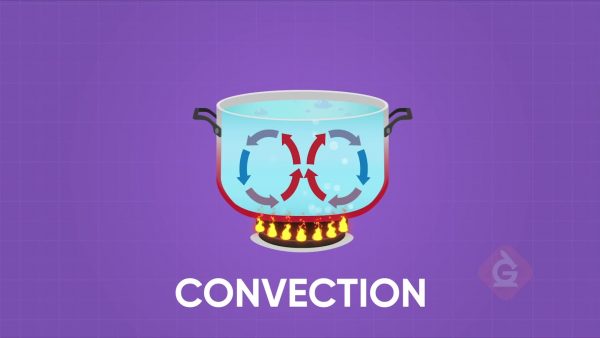
Liquids and gases are not very good conductors of heat. Liquids and gases are fluids; their particles are not fixed in place and move about the bulk of the sample of matter. The model used for explaining thermal energy transfer through the bulk of liquids and gases involves convection. Convection is the process of thermal energy transfer from one location to the next by movement of fluids. The moving fluid carries energy with it. The fluid flows from a high temperature location to a low temperature location.
To understand convection in fluids, let’s consider the energy transfer through the water that is being heated in a pot on a stove. Of course, the source of the thermal energy is the stove burner. The metal pot that holds the water is heated by the stove burner through conduction. As the metal becomes hot, it begins to conduct heat to the water. The water at the boundary with the metal pan becomes hot. Fluids expand (spread out) when heated because the particles are moving faster and colliding and become less dense. So as the water at the bottom of the pot becomes hot, its density decreases. Differences in water density between the bottom of the pot and the top of the pot result in the gradual formation of circulation currents. Hot water begins to rise to the top of the pot displacing the colder water that was originally there. And the colder water that was present at the top of the pot moves toward the bottom of the pot where it is heated and begins to rise. These circulation currents slowly develop over time, providing the pathway for heated water to transfer energy from the bottom of the pot to the surface. Because of all this motion is at the particle level, we added mica crystals to the water, so we could see the circulation current.
Often people will explain thermal energy transfer, or heating, by convection by saying that “heat rises.” To correctly explain this phenomenon, we should say that “heated fluid rises.”
Transfer by radiation
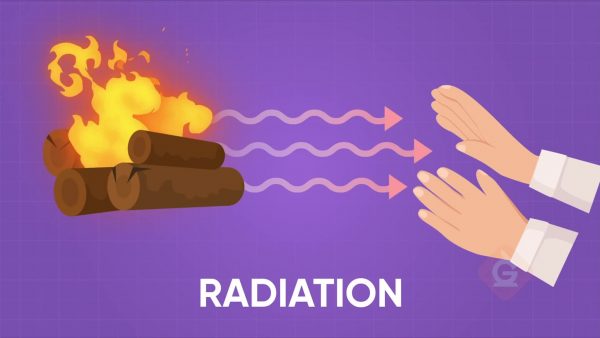
Radiation is the transfer of energy by means of electromagnetic waves. To radiate means to send out or spread from a central location. The transfer of energy by radiation involves the carrying of energy from an origin to the space surrounding it. The energy is carried by electromagnetic waves and does not involve the movement or the interaction of matter. Radiation can occur through matter or through a region of space that is void of matter (i.e., a vacuum). In fact, the energy received on Earth from the Sun is the result of electromagnetic waves traveling through the void of space between Earth and the Sun.
When you sit around a campfire, you can feel its warmth, even if you are not close. That is evidence of the transfer of energy mainly by light and infrared radiation from the fire. (Light and infrared are part of the continuum of wavelengths that form the electromagnetic spectrum.) This energy is absorbed by your skin, causing the average kinetic energy of your skin particles to increase and your skin to feel warm.
Rate of thermal energy transfer
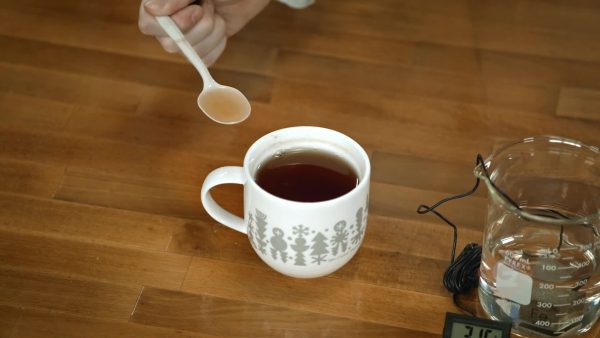
We have learned that heat is the transfer of thermal energy from a high temperature location to a low temperature location. Temperature is the measure of the average kinetic energy of the particles of a substance. And the three methods of thermal energy transfer are conduction, convection, and radiation. But what affects the rate of thermal energy transfer? This topic is of great importance because of the frequent need to either increase or decrease the rate at which heat flows between two locations.
If thermal energy is the motion energy of the particles of a substance, which has more thermal energy—the cup of hot tea or a spoonful of hot tea? It makes sense that the more particles of a substance you have, then the more thermal energy the substance has. The cup of hot tea would have more thermal energy, even if the temperature of the tea is the same in the cup and in the spoon. But which cools down the quickest (has the highest rate of thermal energy transfer)—the tea in the cup or the tea in the spoon? If I have fewer particles of the same substance, then the rate of thermal energy transfer is faster. The tea in the spoon would lose thermal energy more rapidly. So the amount of a substance you have is one factor that affects the rate of thermal energy transfer.
Another factor that affects the rate of thermal energy transfer is the kind of material a substance is made of. We saw that cubes of iron, tin, and bismuth, all the same mass, transferred thermal energy to a beaker of water at very different rates. In the same amount of time, the thermal energy from the iron cube increased the water temperature by 30°C, the tin cube by 15°C, and the bismuth cube by 5°C. Different materials can store different amounts of energy. Knowing this can help us select the best materials to either slow or speed up the rate of thermal energy transfer.
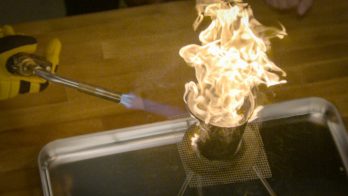
































































































































 Select a Google Form
Select a Google Form












